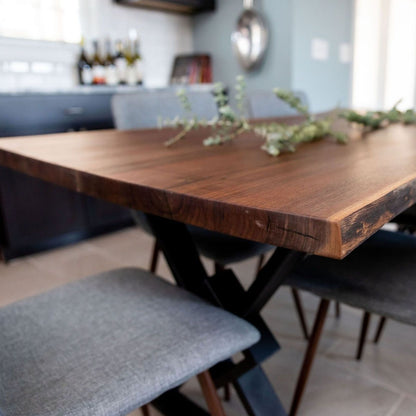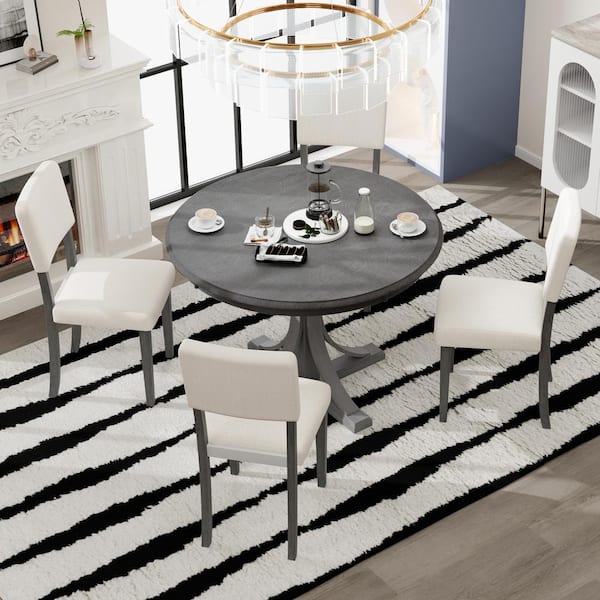Creative Ideas for Replacing or Refurbishing Your Dining Room Table Legs
Creative Ideas for Replacing or Refurbishing Your Dining Room Table Legs
Blog Article
How to Choose the Perfect Dining-room Table Legs for Your Home Decor
Picking the ideal dining-room table legs is a nuanced procedure that needs cautious consideration of different components, including your area constraints, visual choices, and functional needs. The interplay between materials, styles, and dimensions can dramatically influence the setting of your eating location, making it important to approach this decision systematically. As you consider the myriad options available, it becomes clear that the appropriate choice expands beyond mere appearance; it can enhance your overall dining experience. What elements should you prioritize to ensure your choice enhances your home's one-of-a-kind personality?
Assess Your Eating Room
Examining your eating room is critical for selecting the right table legs that match both aesthetic appeals and functionality. Begin by measuring the dimensions of your eating location, consisting of ceiling height, flooring space, and proximity to other furnishings. This details will assist identify the ideal size and height of your eating table, which directly influences the option of table legs.
Following, think about the design and format of your dining room. For circumstances, an open-concept design might benefit from table legs that supply visual lightness, such as slender metal or acrylic options. Conversely, a more conventional setup may ask for strong wooden legs that give a feeling of durability.
Assess the existing color palette and materials in your dining area. Integrating the table legs with these aspects develops a natural appearance that improves the overall style. In addition, consider the performance called for in your area. As an example, if you often organize huge celebrations, think about legs that give additional assistance and security.
Eventually, a detailed evaluation of your dining room will guide you in making a notified decision, making sure that your table legs not only boost the visual appeal yet likewise offer practical objectives.
Consider Your Design Preferences
When picking dining-room table legs, it is vital to assess your individual style preferences, as they dramatically influence the overall visual of your eating space. Your choice of table legs can either complement or contrast with existing decor, making it vital to align them with your preferred interior layout motif.
If your home leans in the direction of a modern visual, consider streamlined metal or minimalist wooden legs that provide a tidy, uncluttered look. For a more typical technique, ornate wood legs with complex makings can add a touch of elegance and refinement. Industrial designs benefit from robust, raw products such as redeemed timber and metal mixes, reflecting a sturdy appeal.
In addition, farmhouse and rustic styles usually prefer durable, chunky legs that stimulate a sense of warmth and convenience. On the other hand, if your décor is eclectic, you might select unusual forms or a mix of products to create visual passion.

Evaluate Product Options
The option of product for dining room table legs plays a pivotal duty in both toughness and visual allure. Common materials consist of wood, metal, and composite options, each offering distinctive features that can affect the total appearance and longevity of your table.
Wood is a traditional choice, known for its warmth and convenience. Woods like oak and walnut offer extraordinary stamina and can be completed in numerous discolorations to match any kind of decor. Softwoods like ache are extra susceptible to scratches and read more damages, making them much less ideal for high-traffic areas.
Metal legs, typically crafted from steel or light weight aluminum, emanate modernity and commercial beauty. They are very long lasting and immune to put on, making them appropriate for households with kids or regular gatherings (dining room table legs). Additionally, metal can be completed in different shades, improving the personalization opportunities
Composite products, such as MDF or laminate, offer affordability and diverse designs. While commonly much less durable than strong timber or metal, they can still provide an elegant look and are usually easy to preserve.
Inevitably, the product you select ought to straighten with your way of life, aesthetic choices, and the level of use your eating table will certainly experience.
Determine Elevation and Size
Choosing the proper elevation and size for your dining-room table is vital for both performance and comfort. The typical elevation for dining tables commonly ranges from 28 to 30 inches, enabling sufficient legroom for many individuals when seated. It is crucial to think about the measurements of your eating my site room and the types of chairs you prepare to use.

Furthermore, think about the proportions of your dining-room. A bigger table in a sizable location can create a grand atmosphere, while a smaller sized table functions well in even more intimate settings. Inevitably, the appropriate height and size will certainly integrate with your general design and enhance the eating experience for you and your guests.
Explore Personalization Possibilities

In addition, the design of the legs can be customized to fit numerous designs, such as rustic, modern, or commercial. For click here to find out more example, tapered legs can stimulate a mid-century modern feel, while beefy, block-style legs may resonate with typical or farmhouse style.
Property owners can additionally discover shade coatings, from all-natural wood discolorations to paint, enabling them to match or comparison with the tabletop and bordering decoration.
In addition, leg elevation can be readjusted to accommodate certain seating setups or individual preferences, enhancing both comfort and capability.
Lastly, distinct decorations, such as carvings or ornamental brackets, can better individualize the table legs, making the eating experience not just a declaration but a meal item in the home. By thinking about these modification options, homeowners can develop a dining-room table that really mirrors their uniqueness.
Conclusion
Choosing the suitable dining-room table legs needs careful consideration of different aspects, including the dimensions of the dining space, design preferences, material durability, and desired elevation. Customization options even more boost the capability to achieve a cohesive aesthetic that enhances the overall decor. By systematically evaluating these components, home owners can make certain that the picked table legs not just satisfy functional requirements however likewise add favorably to the dining experience and setting of the home.
Selecting the excellent eating room table legs is a nuanced procedure that calls for mindful consideration of various components, including your space constraints, aesthetic choices, and practical demands.Examining your dining room is vital for selecting the right table legs that enhance both appearances and capability.When determining dimension, measure the location where the table will certainly be placed to guarantee it fits easily, enabling for at the very least 36 inches of clearance around the table for simple activity. A bigger table in a sizable area can develop a grand atmosphere, while a smaller sized table functions well in more intimate settings.Selecting the perfect eating area table legs requires careful factor to consider of different variables, including the dimensions of the dining room, design choices, product durability, and preferred height.
Report this page